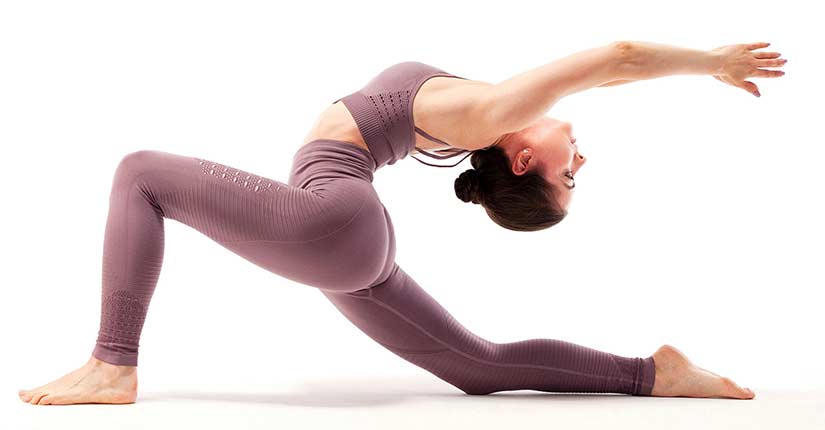
Vinyasa Yoga is a popular style of yoga that focuses on the synchronization of breath and movement. In Sanskrit, “Vinyasa” means “to place in a special way,” indicating the intentional sequencing of yoga poses in a flowing manner.
In a Vinyasa Yoga practice, participants move through a series of poses, transitioning smoothly from one posture to another, often guided by the breath. Each movement is coordinated with an inhale or an exhale, creating a continuous, dynamic flow.
Vinyasa Yoga is known for its fluidity, creativity, and variety. While there are traditional sequences and poses, teachers have the freedom to design their classes and incorporate different postures, making each session unique. The practice typically includes a combination of standing, seated, balancing, and inverted poses, offering a full-body workout that enhances strength, flexibility, and mindfulness.
The breath plays a vital role in Vinyasa Yoga. Practitioners are encouraged to synchronize their breath with each movement, using deep, conscious inhales and exhales. This focus on breath control helps to cultivate a meditative state of mind, promoting relaxation, concentration, and a deeper connection between the body and the mind.
Vinyasa Yoga offers numerous benefits, including improved physical fitness, increased energy levels, enhanced flexibility and balance, stress reduction, and a sense of inner calm. It is suitable for practitioners of various levels, as modifications and variations can be made to accommodate different abilities and needs.
Whether you’re a beginner or an experienced yogi, Vinyasa Yoga offers an invigorating and dynamic practice that brings harmony to the body, mind, and breath.
How to do Vinyasa Yoga
To practice Vinyasa Yoga, follow these general steps:
Find a suitable space: Choose a quiet and well-ventilated area with enough room for you to move freely without any obstructions.
Get your yoga mat: Lay your yoga mat on the floor to provide a comfortable and non-slip surface for your practice.
Begin with centering: Sit in a comfortable cross-legged position, close your eyes, and take a few deep breaths to center yourself and establish a sense of mindfulness.
Warm-up and Sun Salutations: Start with a few gentle warm-up exercises to awaken your body. Then, move into a series of Sun Salutations (Surya Namaskar), which typically include a sequence of poses that flow together with the breath.
Flow through poses: Continue moving through a series of yoga poses, connecting each posture with your breath. The sequences can vary, but common poses in Vinyasa Yoga include Downward Facing Dog (Adho Mukha Svanasana), Plank Pose, Chaturanga Dandasana, Upward Facing Dog (Urdhva Mukha Svanasana), and Warrior Poses (Virabhadrasana series).
Maintain breath awareness: Throughout your practice, pay attention to your breath. Inhale deeply as you move into a pose, and exhale as you transition or deepen into it. Keep the breath smooth, steady, and controlled.
Modify as needed: Vinyasa Yoga allows for modifications and variations. If a pose feels challenging or uncomfortable, feel free to modify it to suit your body’s capabilities. Listen to your body and honor its limits.
Cool-down and Savasana: Towards the end of your practice, gradually slow down the pace and transition into gentler poses or seated stretches. Finally, conclude your practice with Savasana (Corpse Pose), lying flat on your back with your arms and legs relaxed, allowing your body to fully rest and integrate the benefits of your practice.
Benefits of Vinyasa Yoga
Vinyasa Yoga offers a wide range of benefits for the body, mind, and overall well-being. Here are some key benefits of practicing Vinyasa Yoga:
Physical fitness: Vinyasa Yoga provides a full-body workout, improving strength, flexibility, and balance. The continuous flow of poses builds muscular endurance and tone, enhances joint mobility, and increases overall body awareness.
Cardiovascular health: The dynamic and rhythmic nature of Vinyasa Yoga increases heart rate, promoting cardiovascular health and improving circulation. Regular practice can contribute to improved stamina and cardiovascular endurance.
Stress reduction: Vinyasa Yoga incorporates breath awareness and mindful movement, which helps reduce stress and promote relaxation. The focus on the breath and the present moment encourages a sense of calm, alleviating anxiety and promoting mental well-being.
Mind-body connection: Vinyasa Yoga emphasizes the synchronization of breath and movement. This cultivates a deep connection between the body and the mind, fostering mindfulness and enhancing body awareness. Practitioners learn to be fully present in the current moment and develop a greater understanding of their physical and mental states.
Increased energy and vitality: Vinyasa Yoga stimulates the body’s energy flow through the combination of breath and movement. The practice can help increase energy levels, invigorate the body, and uplift the mood. It can also help combat feelings of fatigue and improve overall vitality.
Improved flexibility and mobility: Vinyasa Yoga incorporates a wide range of poses that promote flexibility and enhance joint mobility. Regular practice gradually increases flexibility, making everyday movements easier and reducing the risk of injuries.
Mental focus and concentration: The mindful nature of Vinyasa Yoga requires focus and concentration. As practitioners move through the sequences with intention and awareness, they develop mental clarity, improve concentration, and enhance cognitive function.
Emotional balance: Vinyasa Yoga can help balance emotions and enhance emotional well-being. The combination of movement, breath, and mindfulness can reduce negative emotions, promote positive feelings, and provide a sense of inner calm and balance.
Body detoxification: The combination of dynamic movements, deep breathing, and increased circulation in Vinyasa Yoga supports the body’s natural detoxification process. Sweating during the practice helps release toxins, cleanse the body, and promote overall well-being.
Self-expression and creativity: Vinyasa Yoga offers a creative and flowing practice where practitioners have the freedom to explore and express themselves through movement. It encourages self-expression, fosters creativity, and allows individuals to personalize their practice.
© Indian Yoga Expert 2026 | All Rights Reserved
© Indian Yoga Expert 2026 | All Rights Reserved